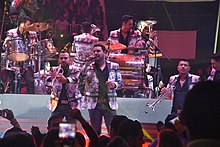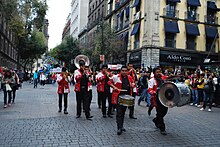Banda music
| Banda music | |
|---|---|
| Stylistic origins | Mexican sones |
| Cultural origins | Mid-19th century inOaxaca,Yucatan,Morelos |
| Typical instruments | Tuba,Trumpet,Trombone,Snare drum,Tambora |
| Derivative forms | Duranguense |
Bandais a subgenre ofregional Mexicanmusic and type of ensemble in whichwind(mostlybrass) andpercussioninstruments are performed.
The history of banda music inMexicodates from the middle of the 19th century with the arrival ofpistonbrass instruments, when community musicians tried to imitate military bands. The first bandas were formed in Southern and Central Mexico. Many types of bandas exist in different territories and villages, playing traditional or modern music, organized privately or municipally.
Traditional ensembles
[edit]
Brass instruments in the state of Oaxaca of European origin that date back to the 1850s have been found. The repertoire of the bands of Morelos, Guerrero, Oaxaca, Chiapas and Michoacán coveredgustos,sones,vinuetes,funeral pieces,marches,danzones,valses,corridos,paso dobles,polkas,rancheras,alabanzas,andfoxes. Traditional bands that playYucatecan Jaranaare instrumented withclarinet,tenor saxophone,baritone saxophone,trumpet,trombone,timbales,snare drum,bass drum,cymbals,andgüiro.

Traditional Oaxacan bands use a mix of tuba, saxophones and clarinets, fewer trumpets and more tenor trombones, and the bass drum and cymbals are played separately.
One of the oldest bands recorded in history is the Banda de Tlayacapan of the state of Morelos, founded approximately in 1870 and being one of the first to playla danza del Chinelo.
Traditional Zacatecantamborazobands do not use tuba, thetamborataking the bass voice instead.
Repertoire
[edit]Brass bandas play a wide variety of song styles includingrancheras,corridos,cumbias,charangas,ballads,boleros,salsas,bachatas,sones,chilenas,jarabes,mambos,danzones,tangos,sambas,bossa novas,pasodobles,marches,polkas,waltzes,mazurkas,chotís,andswing.
Perhaps the most popular song played by bandas is "El Sinaloense"(" The Sinaloan "), written bySeveriano Briseñoin 1944. "El Sinaloense" has been recorded by hundreds of bandas, in both lyrical and instrumental versions. The song has become so popular that many Sinaloans consider it their unofficial anthem.[1]
History
[edit]
Banda music in Mexico dates from the middle of the 19th century, and more specifically theSecond Mexican Empirewith the arrival of piston metal instruments, when the communities tried to imitate the military bands. In each village of the different territories there are certain types of wind bands, whether traditional, private or municipal.
Banda music was established in the 1880s in the Mexican state ofSinaloaand expanded to other nearby states in the 1890s. Its roots come from the overlapping of Mexican music with polka music. At the time, many GermanMexicanslived in the states of Sinaloa,Chihuahua,Oaxaca,Yucatan,JaliscoandNuevo León.This greatly influenced northern Mexican music. Immigrants from northern Mexico brought the music to the United States. Initially popular in the southwest United States, primarily inTexas,California,andArizona,banda has followed the movement of Mexican immigrants to theMidwest United Statesand the rest of the country. Mexicans who came in contact with Latin-based Jazz ofChicanosor Mexicans born and raised in the United States adopted jazz-like sounds in banda to further enrich the music type.
Despite some having provided the music for solo vocalists such asJosé Alfredo JiménezandAntonio Aguilarin years past, when it came time to record their own music, brass bandas almost exclusively performed instrumentals. In 1989,Banda el Recodowas the first brass banda to record songs with its own official vocalist, inspiring most bandas to follow suit. Famous banda soloists includeJulio Preciado,Lupillo Rivera,Valentín Elizalde,Pepe Aguilar,Joan Sebastian,José Manuel Figueroa,Pancho Barraza,El Chapo de Sinaloa,El Coyote,El Potro de Sinaloa,Adán Sánchez,Sergio Vega,Espinoza Paz,Roberto Tapia,Julión Álvarez,Larry Hernández,Gerardo Ortíz,Regulo Caro,Luis Coronel,El Dasa,Leonardo Aguilar,Remmy Valenzuela,andAlfredo Olivas.Chalino SánchezandJuan Gabrielalso contributed to banda music.
Throughout the 20th century, brass banda music's mainstream popularity was traditionally confined to the state ofSinaloa.However, starting in the late 1980s and throughout the 1990s, it gained ground in the rest of Mexico's pacific states, as well as a number of central states. By the new millennium, however, brass banda started to become popular throughout the rest of Mexico, eventually becoming the most popular Regional Mexican subgenre for several years.


Despite banda being male-dominated, there are a number of female soloist banda singers such asGraciela Beltran,[2]Diana Reyes,Beatriz Adriana,andYolanda Pérez.Jenni Rivera,the highest-earning solo banda singer of all time, has been credited with bringing a female perspective to what had historically been a male-dominated genre.[3][4][5]While not known primarily as banda singers,Ana BárbaraandNinel Condehave also recorded in the genre.

The 2010s wave of popularity of thetubain Southern California has been credited to its presence in banda music.[6]As of 2017,El Salvadorstarted having its own Banda music.
Traditional brass banda sound
[edit]A standardSinaloa-style banda is made up ofbrass,woodwind,andpercussion instruments.The most notable instrument is thetambora,a type of bass drum with a head made from animal hide, with acymbalon top. Bandas were previously called "tamboras," named after this drum. The tambora is played in a strong and embellished manner, which provides the drive for the rest of the band. The percussion section also includes thetarola,which is a snare with timbales resembling the tom-toms on a regular drum set,cowbells,and cymbals.Banda el Recodo,one of the most famous bandas,[7]features threetrumpets,fourclarinets,threevalve trombonesorslide trombones(the former being more common), two E♭alto horns,and onesousaphone.

Like an orchestra, a banda can be organized into different sections.
- Bass: The lowest-pitched part is played by thesousaphone(referred to as a "tuba"in Mexico).
- Percussion:Tambora(a large bass drum) with a cymbal on top.
- Harmony: Two Armonias, "charchetas" or "saxores" in Mexico (E♭alto horns), play using different rhythms, depending on the style.
- Tenor:valve trombonesorslide trombonesplay in the lower register.
- Alto:Trumpetsplay in the upper register.
- Soprano:Clarinetsand sometimessaxophonesplay as "singing" instruments that may double the voice.
- Vocals: Banda el Recodo has two vocalists, whileBanda Jerezhas one. However, some bandas consist of as many as three vocalists.
Most banda arrangements feature three-part harmony and melodic sections which contrast the timbres of the clarinet, trumpet, and valve trombone or slide trombone sections.
Historically, bandas were village brass bands called on to entertain the town, and would play anything from opera overtures to big band jazz. This tradition continues today in many towns, especially during festivals and celebrations.
Bandas usually have a strong percussion. The percussionists generally provide the accents and do not usually play all the time or keep a 'groove'. Often the percussionists will enter only when the singer is not singing, such as in an instrumental chorus. The groove is mostly provided by the sousaphone (or bass guitar in a few recordings) playing the bass line, and the alto horns playing sharp upbeats. Typically when a banda plays a cumbia, the alto horn players switch to Latin percussion instruments such astimbales,maracas,cowbell,congas,bongosandguiro.
Bandas generally contain between 10 and 20 members. They usually have a lead singer and a second voice, and occasionally a third voice. The voice often consists of a duet, but solo singers and trios are also common.
Besides the typical instrumentation, banda music, as well as many other forms ofRegional Mexicanmusic, is also noted for thegrito mexicano,a yell that is done at musical interludes within a song, either by the musicians and/or the listening audience.
Similar genres
[edit]Technobanda
[edit]In the late 1970s, a new style ofRegional Mexicanmusic was developed in the state ofNayaritcalledTechnobanda.Pioneered by bands such asBanda Machos,Mi Banda El Mexicano,Banda MagueyandBanda Arkángel R-15,it is essentially a hybrid of traditional banda withGrupero music.Beginning in the late 1980s, its popularity spread to the rest of Mexico's western states as well as a number of central states, and among the Mexican population in United States from said regions. The 1990s was the peak of Technobanda's popularity. In this subgenre, some or all of the horns are replaced by electric instruments. A typical Technobanda will substitute asousaphonewith anelectric bassand the alto horns with anelectronic keyboardand anelectric guitar.The clarinets are frequently replaced withsaxophones,while adrum setreplaces the snare drums. The genre popularized the dance styleQuebradita.Technobandas had already established vocalists within their repertoire before brass bandas officially added their own vocalists.
Tierra Caliente
[edit]In the late 1980s, another style of Regional Mexican music was developed in the state ofMichoacancalledTierra Caliente.Like Technobanda, it includesvocals,electric instruments like a bass guitar and electronic keyboard, as well as brass instruments such astrumpets,trombones,saxophonesanddrums.Some bands also useaccordions.Tierra Caliente's popularity was originally limited to theregions of Mexico it is named afteras well as among the Mexican population living in the United States from said regions, but starting in the mid-2000s, it gained popularity throughout a number of Mexico's central states, as well as in the United States among the Mexican population from said regions.
Duranguense
[edit]Duranguensewas created in the early 1990s. It first became prominent inChicago, Illinoisand surged to widespread popularity during the mid to late 2000s among the Mexican and Mexican-American community at large in theUnited States,as well as in many parts ofMexico.The instrumental line-up includes vocals, saxophones, trombones, keyboards, drums and atambora.This genre popularized the dance stylePasito Durangense.
The main differences between Technobanda, Tierra Caliente and Duranguense is that the synthesizer riffs are different for all three styles of music, and the fact that Duranguense includes a tambora, while the others do not. Also, Technobanda may include an electric guitar, while the other two traditionally do not, and each subgenre has between one and three vocalists per band. The three subgenres simultaneously producerancheras,corridos,cumbias,charangas,ballads,boleros,sones,chilenas,polkasandwaltzes.
Tamborazo
[edit]Tamborazois closely related to traditional brass banda. However, Tamborazo usessaxophonesinstead ofclarinets.Another difference from banda is that Tamborazo uses its drum consistently, as opposed to banda which distributes the use of the other instruments throughout a song. Tamborazo originated inVillanuevain the state ofZacatecas.It is traditionally popular in that state, as well as in the states ofChihuahua,Durango,andSan Luis Potosi,and among the Mexican population from said states residing in the United States.
Tamborazo uses various instruments such as:
Tamborazo bands tend to focus more on instrumentalsones,polkas,waltzes,marches,cumbiasandmambos.
See also
[edit]- Music of Mexico
- Regional Mexican music
- Grammy Award for Best Banda Album
- Latin Grammy Award for Best Banda Album
- Mariachi
- Grupera
- Norteño
- Tejano
- New Mexico music
References
[edit]- ^"¿Quién escribio el Sinaloense?".Mazatleco.Archived fromthe originalon 30 September 2018.Retrieved30 September2018.
- ^"AllMusic Review by Phil Freeman".AllMusic.
- ^"The Death of an Independent Latina: Jenni Rivera (1969-2012)".Time.10 December 2012.
- ^Cobo, Leila (December 9, 2012)."Jenni Rivera, Big-Voiced Queen of Banda, Dead at 43".Billboard.Prometheus Global Media.Retrieved4 April2015.
- ^Mejía, Iván."Exposición 'Jenni Rivera, la Gran Señora'".Vivelohoy(in Spanish). Archived fromthe originalon 2015-04-17.Retrieved4 April2015.
- ^Lovett, Ian (10 February 2012).""Tuba Raids" Plague Schools in California ".The New York Times.
- ^"Banda El Recodo banda member Aldo Sarabia murdered".

